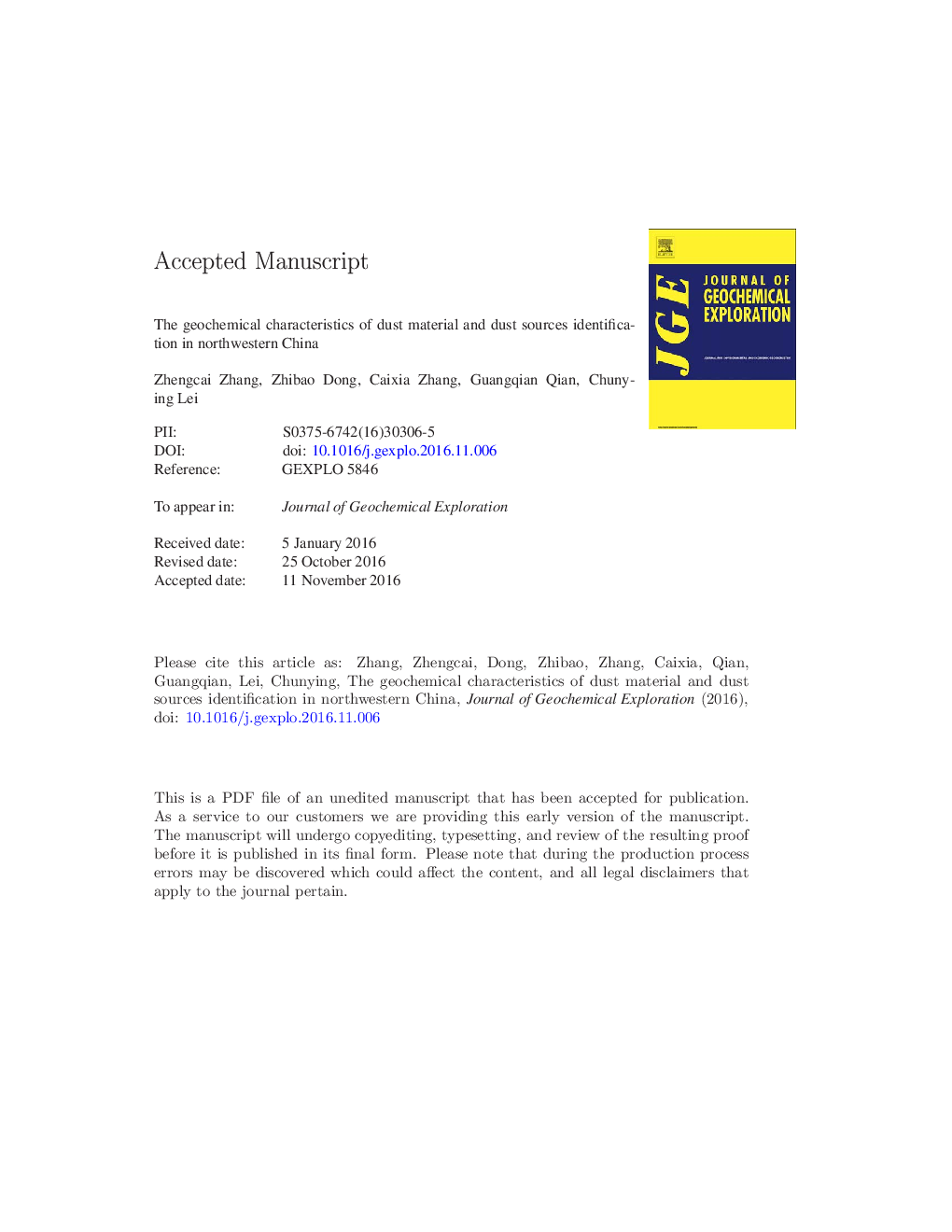| کد مقاله | کد نشریه | سال انتشار | مقاله انگلیسی | نسخه تمام متن |
|---|---|---|---|---|
| 5754575 | 1620884 | 2017 | 33 صفحه PDF | دانلود رایگان |
عنوان انگلیسی مقاله ISI
The geochemical characteristics of dust material and dust sources identification in northwestern China
ترجمه فارسی عنوان
مشخصات ژئوشیمیایی مواد گرد و غبار و شناسایی گرد و غبار در شمال غربی چین
دانلود مقاله + سفارش ترجمه
دانلود مقاله ISI انگلیسی
رایگان برای ایرانیان
کلمات کلیدی
ژئوشیمیایی، عنصر ردیابی، عنصر اصلی، منابع گرد و غبار،
موضوعات مرتبط
مهندسی و علوم پایه
علوم زمین و سیارات
زمین شناسی اقتصادی
چکیده انگلیسی
To determine dust sources in the northwestern China, the spatial distribution of dust geochemical elements in the Hexi Corridor Desert, a total of 40 samples were collected at a height of 1.5 m over sandy and gravel surfaces at six field sites. In this work, 21 trace elements and seven major oxides were analyzed. Land surface characteristics influenced the dust emission, and the percentages of transported silt, clay, silt/sand, and clay/sand at a height of 1.5 m were related to gravel cover and the percentage of 0.063-mm-sized grains at the surface. The SiO2 content was the highest (mean 61.20 ± 9.17%), whereas the K2O content was the lowest (mean 1.9 ± 0.3%) in all field sites. For the six sites, the Ti content was the highest (mean 3247.5 ± 502.5 μg/g) and the Nb content was the lowest (mean 9.6 ± 1.9 μg/g). At all sites, Co, As, and Nd were enriched, whereas Mn, Ti, Sr, Ce, Ni, Rb, Y, P, V, Ga, and Ba were depleted. P, Ti, V, Ni, Rb, Sr, Y, Ba, and La originated from crustal sources, and Cl, Cr, Cu, and Zn were sensitive to anthropogenic activity. The main transported trace elements were Ti, Mn, Ba, P, Cl, Sr, and Zr, which accounted for > 90% of the total trace elements. PCA analysis indicated that two principal components with eigenvalues > 1 could be extracted from the data. The relationship between Rb/Sr and Ba/Sr and between Fe/Al, Mg/Al, and Ca/Al was used to identify dust sources. Two dust sources were identified in northwestern China: one source comprised the Badain Jaran Desert, Tengger Desert, Hexi Corridor Desert, and part of the Inner Mongolian Gobi Desert, and the other source comprised the desert adjacent to Dunhuang Gobi Desert, and part of the Inner Mongolian Gobi Desert.
ناشر
Database: Elsevier - ScienceDirect (ساینس دایرکت)
Journal: Journal of Geochemical Exploration - Volume 175, April 2017, Pages 148-155
Journal: Journal of Geochemical Exploration - Volume 175, April 2017, Pages 148-155
نویسندگان
Zhengcai Zhang, Zhibao Dong, Caixia Zhang, Guangqian Qian, Chunying Lei,
